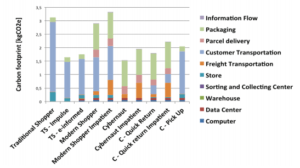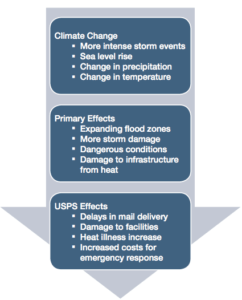Online Shopping, Sustainable Shipping

Online shopping cuts shoppers' carbon footprint by half. Are delivery service providers like USPS seizing this opportunity to become sustainable?
Environmental Impact of Online Retail
With the explosion of online retail, consumers are choosing click and mortar retail over traditional brick and mortar stores. Online retail presents a unique opportunity to have a positive impact on the environment and prevent climate change. Online consumer’s behaviors are more efficient and sustainable than a traditional consumer. Maintaining a website as opposed to a physical store is one obvious way to decrease carbon footprint. However, less evident but still very dramatic benefits in sustainability comes from logistics of delivery.

Greener Delivery
On average, the carbon footprint of a “Cybernaut”, defined as a shopper who performs all of the buying process—searches, purchases, and returns—online, is almost half of that of a “Traditional Shopper”, a shopper who shops only in physical stores [1]. This is due to the fact that parcel carriers optimize the delivery process for many customers while a traditional shopper produces a lot of emissions from the customer transporting back and forth from the stores, and often making multiple trips. Even with higher return rates, online shopping has a lower carbon footprint than traditional shopping due to massive savings caused by saving on transportation.
Carbon emission savings in grocery delivery illustrate this effect even more clearly. Trucks optimized for delivery to be filled to capacity and on routes optimized for delivery will deliver to a clustered network of consumers, can cut carbon emissions by half, compared to individual consumers purchasing groceries at the store [2].

Furthermore, because fuel cost is often the most significant cost, logistics providers are placed in a unique position of being incentivized to be sustainable. Becoming fuel efficient and saving on operating costs will not only cut greenhouse gas emissions but also improve their bottom line. Which begs the question: how are delivery service providers dealing with sustainability?
USPS and Climate Change
As the federal agency providing delivery services to any address in the entire U.S., USPS is one of the most important delivery service providers in the U.S [3].
USPS has reported their carbon emission every year since 2008. USPS also created a committee called Climate Change Adaptation Working Group (CCAWG) to address specific issues related to climate adaptation planning. CCAWG meets monthly and sets roadmaps and milestones to make USPS more sustainable and adaptable to climate change [4].
USPS’ policies are summarized as:
- Climate Change Integration and Collaboration
- Maintain awareness of climate change and monitor implementation of climate planning activities.
- Employees
- Protect employees from climate related risks such as safety while delivering in extreme weather
- Network and Fleet
- Consider climate change and disaster management when deciding to change network operations facilities
- Facilities and Infrastructure
- Evaluate climate risk for plans related to equipment and real estate of facilities

While USPS Climate Change Adaption Plan addresses how to minimize the operational hindrance climate change might have, their plan is limited to risk mitigation. They do not address how to improve their operations by making it more sustainable. USPS pales in comparison to other delivery service providers that are leveraging sustainability to improve their operations.
DHL
DHL perhaps due to the fact that it is a much bigger and global delivery service provider, has made a more tangible action plan in addressing Climate Change. In 2007 DHL committed to reducing their carbon footprint by 30% by 2020. Since then they have adopted many sustainable practices to become more environmental and more operationally efficient.
Some examples of their practices include [5]:
- Deploying more fuel efficient vehicle such as electric or hybrid vehicles, aerodynamically engineered trucks
- Replacing old aircraft carriers with newer models and optimizing cargo space to be more fuel efficient
- Using technology to calculate the best delivery routes to increase efficiency
- Providing “Climate Neutral” delivery methods by offsetting with voluntary emissions trading schemes
UPS
UPS, one of DHL’s competitors, also published their Climate Change Statement, a commitment on how to select climate change policies. Their resolutions are very similar to DHL’s plans and revolve around network and mode optimization (logistics optimization), investing in fuel-efficient or alternative fuel technologies, and reporting greenhouse gas data in compliance to governing bodies [6].
Room for Improvements for USPS
As USPS is neither international nor private, imposing DHL and UPS’ standard of commitment to Climate Change on USPS would be unfair. However, given the massive potential for carbon emission decreases in the delivery industry as online retail continues to grow, USPS should further implement ways to become more fuel efficient in their vehicles and optimize their routes.
Sources
[1] Dimitri Weideli, “Environmental Analysis of US Online Shopping,” http://ctl.mit.edu/sites/ctl.mit.edu/files/library/public/Dimitri-Weideli-Environmental-Analysis-of-US-Online-Shopping_0.pdf
[2] Michelle Ma, “Grocery Delivery Is Greener Than Driving To The Store,” http://www.washington.edu/news/2013/04/29/grocery-delivery-service-is-greener-than-driving-to-the-store/
[3] “Climate Change Adaptation Plan,” United States Postal Service, accessed November 3, 2016, http://about.usps.com/who-we-are/leadership/about-usps.htm
[4] “About the United States Postal Service”, United States Postal Service, accessed November 3, 2016, https://about.usps.com/what-we-are-doing/green/pdf/CCAP_FINAL_2014.pdf
[5] “DHL Go Green Solutions,” DHL, accessed November 3, 2016, http://www.dhl-usa.com/en/about_us/green_solutions.html
[6] “UPS Environmental Policy Statement and Environmental Guidance Statements”, UPS Press Room, accessed November 3, 2016, https://pressroom.ups.com/pressroom/ContentDetailsViewer.page?ConceptType=FactSheets&id=1426321598574-579
Exhibit 1. Dimitri Weideli, “Environmental Analysis of US Online Shopping,” p 5. http://ctl.mit.edu/sites/ctl.mit.edu/files/library/public/Dimitri-Weideli-Environmental-Analysis-of-US-Online-Shopping_0.pdf
Exhibit 2. Michelle Ma, “Grocery Delivery Is Greener Than Driving To The Store,” p 1. http://www.washington.edu/news/2013/04/29/grocery-delivery-service-is-greener-than-driving-to-the-store/
Exhibit 3. “UPS Environmental Policy Statement and Environmental Guidance Statements”, UPS Press Room, accessed November 3, 2016, https://pressroom.ups.com/pressroom/ContentDetailsViewer.page?ConceptType=FactSheets&id=1426321598574-579
Word count (excluding sources): 791



I very much enjoy your post because it addresses logistics issues that not only companies in the delivery “system” have to deal with, but also every other company that produces some sort of good that needs to reach stores or consumers. Thanks for bringing that up!
I also agree that, despite not having the same availability of funding as other companies, USPS is positioned to start taking action regarding its own sustainability standards. As the owner of one of the largest civilian vehicle fleet in the world (https://about.usps.com/who-we-are/postal-facts/top-12-things-to-know.htm), it is highly responsible for its lower of standards and the impact it can have on global climate change! The company should definitely explore ways of incorporating more fuel efficiency practices, lower emissions in its operations and potentially go even beyond: why not having their partners together in this journey (sharing technologies, best practices or even finding ways of further optimizing logistics)?
Thank you for your post! I agree that, even if USPS doesn’t have the resources that its competitors DHL and UPS have, it can still address how to make its operations more sustainable. I am thinking about what role the end consumer (and recipient of USPS packages) could play towards turning the firm’s operations more sustainable. Maybe incentivize them to recycle the carton/paper from the packages? I am sure there could be several ways to engage the consumers on this!
Really interesting comparison between 2 private competitors (DHL and UPS) with a public competitor (USPS)! This comparison highlights an important element of sustainability that is often underappreciated — “going green” is usually expensive in short-run, requiring substantial upfront investments. While these investments will often pay for themselves in the long-run, the upfront cost can be a more significant barrier for some companies.
In 2015, the USPS created the Next Generation Delivery Vehicles (NGDV) program to obtain a new vehicle fleet that will reduce its environmental impact. It looks like USPS awarded Mahindra the contract in October of this year, and Mahindra will have 1 year to complete the prototyping.
http://www.prnewswire.com/news-releases/us-postal-service-selects-mahindra-to-produce-next-generation-delivery-vehicle-ngdv-prototypes-300338021.html
How will this upgrade to the USPS fleet change their “ranking” in relation to DHL and UPS? Is USPS doing something similar with their airplanes to reduce carbon emissions?
I’d also be interested to learn more about their contingency / mitigation plans for the new, unpredictable weather patterns associated with climate change. As weather patterns become more variable, is it possible to anticipate and mitigate the effects? Is one possible solution simply adding a “buffer” of delivery time to account for the unpredictability.
Very thought-provoking post – thanks for sharing!
Very interesting article! I would have assumed that online shopping results in a larger carbon footprint due to constant deliveries and returns. Your chart of individual shoppers versus a single delivery system was very helpful in illustrating why delivery systems are preferable.
Your article left me curious about the incentives delivery companies (UPS, DHL etc.) have to reduce their carbon emissions (other than goodwill). It is my experience that online retailers pair with 1 delivery company or offer the option of multiple based on price. If delivery companies have to invest to become sustainable how will they convince retailers and/or shoppers to pay more for greener services?
Great blog post! I, like several folks who already commented above, would have assumed the online shopper had a larger carbon footprint. I come from NYC, and I would frequently shop online. I often felt guilty because I’d order one small item, and the lone item would be delivered to my apartment in a giant box with a ridiculous amount of packing materials. I know online retailers try to get you to increase your basket size, but do you think there is some messaging the retailer could use to alert people at the time of purchase on how to be greener (e.g. give a shipping discount whenever you buy in bulk + donation to a green charity, or let the customer donate 25 cents to offset their carbon footprint)? Whenever I did shop in stores, I usually walked there or took public transportation, like the subway. So in my case, my carbon footprint was very low compared to someone living in a more suburban or rural area and traveled by car. However, those products I purchased in stores still had to be shipped/delivered to that store and THEN I had to still get them home, so it makes sense to me that delivery straight from a warehouse to my home could reduce emissions. Furthermore, you mentioned the significant carbon footprint of maintaining the brick and mortar store.
It makes perfect sense to me that more fuel efficient vehicles, optimized delivery routes, and optimized packing of boxes would help reduce emissions. I wonder if these companies have experimented with more out-of-the-box delivery solutions, such as electric-powered bicycles, or waste reduction, like box collection for recycling instead of relying on the consumer to properly recycle the box. I’m also curious what innovation is happening around shipping materials — certainly retailers have incentives to reduce the amount of shipping materials, but why are items so often packaged inefficiently?